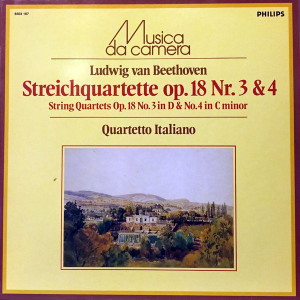 |
|
Philips
- 1 LP - 6503 107
|
|
QUARTETTO ITALIANO
- Paolo Borciani, Elisa Pegreffi, violino
- Piero Farulli,
viola
- Franco Rossi, violoncello |
|
|
|
|
|
Luogo e data
di registrazione |
|
La
Salle des
Remparts, La
Tour-de-Peilz
(Svizzera):
- 13-24 gennaio
1972 (Op. 18 No.
4)
-
20-31 luglio
1975 (Op. 18
No. 2)
|
|
|
Registrazione: live
/ studio |
|
studio |
|
|
Producer / Engineer |
|
Vittorio Negri |
Tony
Buczynski |
|
|
Edizione LP |
|
Philips | 6503
107
| 1 LP |
|
|
Prima Edizione CD |
|
Vedi link alla prima
edizione in long playing.
|
|
|
Note |
|
La
collana
"Musica da
Camera" della
Philips
riedita negli
anni
'80
alcune
registrazioni
del Quartetto
Italiano. |
|
|
|
|
Beethoven
started
composing
string
quartets
relatively
late, around
1798.Possibly
he wanted
forst to reach
a certain
degree of
maturity in
his studies of
counterpoint.
Evidently he
regarded as
essential a
command of
polyphonic
style, fugue,
canon, and
part-writing.
When
working in a
new field it
was natural
for Beethoven
to adhere to
established
patterns.
There is
surely more
than
superficial
significance
in the fact
that he began
with a series
of six
quartets, such
as Mozart had
produced in
1785 and Haydn
in 1790. But
as well as
these two
masters the
influence of
his own
previous
compositions
is also clear.
Right
at the start
of op. 18 No.
3 one is still
very aware of
the division
of the parts
into melodic
and
accompanying
lines; the
cello in
particular
takes very
little part in
the thematic
activity. The
normal calm
centre of a
Beethoven
quartet is
occupied here
by the Andante
con moto
of the second
movement,
whose
exceptional
lenght has
been remarked
on by many
critics. The
typical
Beethoven is
in evidence in
the
scherzo-like Allegro.
This type of
movement was
to be among
the first to
be fully
developed by
Beethoven. But
he does not
seem to be
completely in
his element
until the
finale, which
gives greater
prominence to
fugal and
canonic
writing.
Some
mystery
surrounds Op.
18 No. 4,
which plainly
does not
really belong
in this set.
In the absence
of sketches,
such as we
have for the
other five
quartets of
Op. 18, any
conclusions
about dating
the work must
be tentative.
Hugo Riemann,
arguing from
close study of
the style,
claimed that
he could pick
out the hand
of the young
Beethoven of
the Bonn
years; Vincent
d'Indy, on the
other hand,
lays
particular
stress on the
similarity
between the
first movement
and that of
the Septet,
and points to
a relationship
with the First
Symphony that
he finds in
the fugal
openings of
both second
movements.
Whatever
be the answer
to the problem
of dating the
work, there is
no doubt that
from the very
first bars we
find Beethoven
completely in
his element,
revelling in a
passionate
outpouring of
beatiful sound
(the key of C
minor had a
particular
attraction for
him).
The
scherzo not
only takes
the place of
the slow
movement, but
also resembles
one in its
content, and
tension is
finally
resolved only
in the
following
minuet. The
finale is in a
different kind
of C minor
from the first
movement; here
we have a
series of
short, rapid
sections,
agreable and
entertaining,
in contrast to
the tragic and
dramatic
atmosphere of
the opening.
Hans
Schmidt
|
| Illustration:
Thomas Ender (1793-1875)
"Döbling. Blick af dem
Kahlenberg" (Historisches
Museum der Stadt Wien)
|
|